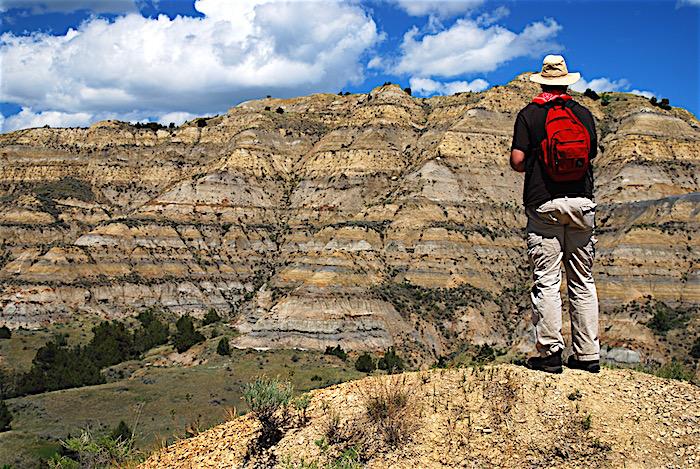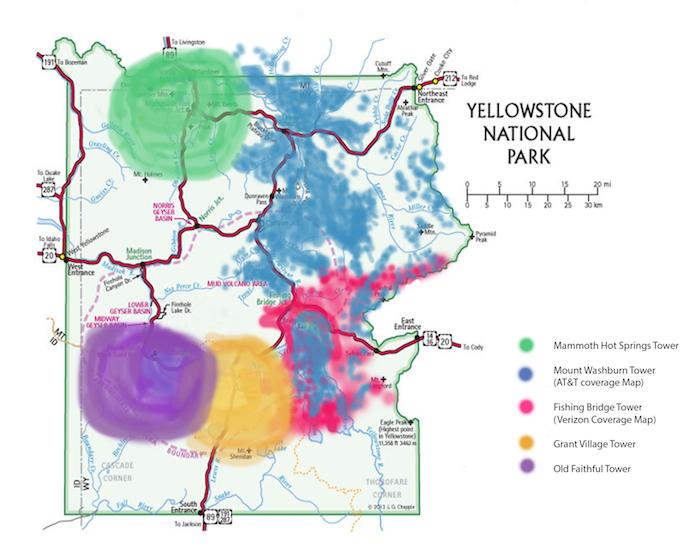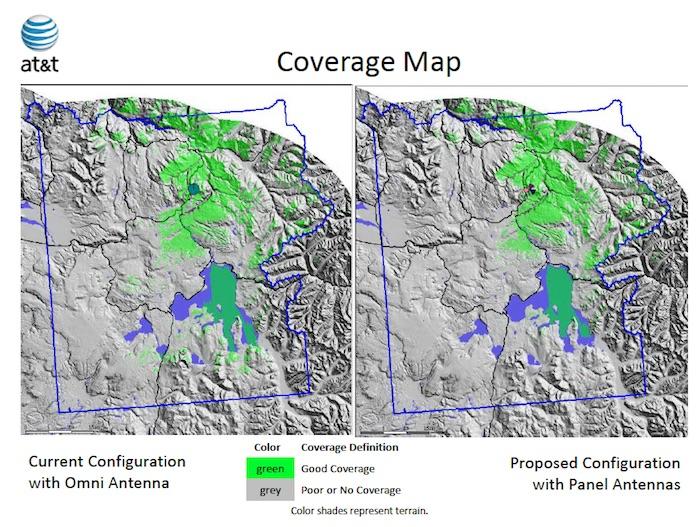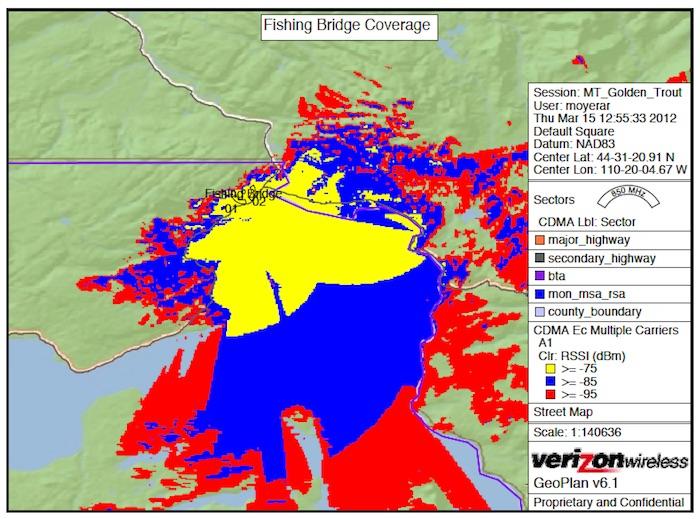
Can the National Park Service reduce cell phone service in the North Unit wilderness of Theodore Roosevelt National Park?/Kurt Repanshek file photo
If you carry a cell phone into a national park, should you expect connectivity? Many people would answer "yes." But what if you hiked into a wilderness area, which is supposed to be free of today's human technologies?
With more and more cell towers springing up around the country, the ability for managers in the National Park System to draw a hard line on where cell coverage flows is being taken out of their hands. So much so that President Lyndon B. Johnson's sentiments upon his signing of the Wilderness Act are increasingly difficult to hold up:
“If future generations are to remember us with gratitude rather than contempt, we must leave them something more than the miracles of technology. We must leave them a glimpse of the world as it was in the beginning, not just after we got through with it,” said President Johnson.
The ubiquitous nature of cell phones and their ability to be not just tools for calling but for taking photos, filming videos, recording sounds, plotting and following GPS coordinates, and measuring not just temperatures but also elevation and barometric pressure, have driven demands for connectivity.
For more than five decades, since passage of the Wilderness Act in 1964, land managers have grappled with what are appropriate experiences and "tools" in wilderness. Most notably in recent years, one topic drawing considerable debate involves the question of whether mountain bikes should be allowed in official wilderness, a thorny issue. But the use of cell phones in wilderness also is controversial, as Public Employees for Environmental Responsibility reminds us with their challenge to consideration by staff at Theodore Roosevelt National Park in North Dakota to share a communications tower with Verizon.

This is PEER's depiction of how much cell signal spillover exists in Yellowstone National Park, an interpretation park officials disagree with/PEER
“We don’t object to them replacing (the tower)," said PEER Executive Director Jeff Ruch, but “from what we could tell, this would blanket designated wilderness with cell phone coverage. ... There’s working with Verizon, and then there’s bending over with Verizon. As we just went through with Yellowstone, are they taking any steps to prevent spillover into wilderness? No.”
At Theodore Roosevelt, Superintendent Wendy Ross notes that no final decision has been reached on the question of sharing a cell tower with the communications giant. But she does point out that if the National Park Service declined Verizon's request, the company has looked at another location outside the park that would actually increase cell phone coverage in wilderness areas in her park's North Unit.
"It’s difficult to say what the impacts are on wilderness by having more cell phone coverage," she said during a phone conversation. ”You’d have less cell phone coverage in wilderness if you put that tower in the park than if you put it in their original location. That’s simply because it was a more optimal location that they had chosen at the get go. ... What does having more cell phone coverage in wilderness mean? How do you measure impacts to one resource against impacts to another, or perceived impacts to another.”
Bill Whitworth, Theodore Roosevelt's chief of resources, also noted that there already is cell phone coverage in the North Unit's wilderness as a result of cell towers located elsewhere outside the park, and in the South Unit's wilderness you also can find coverage.
Which brings us back to the question of how we should value officially designated wilderness and to what extent it should be shielded from today's technology. In January 2014, the National Park Service published Keeping It Wild in the National Park Service, a User Guide to Integrating Wilderness Character into Park Planning, Management, and Monitoring. In that 240-page document, the agency noted that, "There are a number of things on the horizon that could degrade opportunities for solitude or primitive and unconfined recreation. Unmitigated impacts of increased visitation, and increased availability and use of technology — from satellite phones to web cams to personal tracking devices — diminish solitude."
Yellowstone officials long have drawn PEER's ire over their dealings with cell phone coverage. Back in 2012, the advocacy group warned that "the electronic tendrils of cellular signals will penetrate even deeper into the heart of Yellowstone National Park if another cell tower receives final approval ...."
More recently, this past September, the group charged that much of Yellowstone's "wild backcountry" is reached by cell phone signals.
“The park has taken no step to limit backcountry coverage," Mr. Ruch claimed in that September release.

This map provided to the National Park Service depicts how AT&T intended to limit cell signal spillover from its antenna atop Mount Washburn/NPS
At Yellowstone, Bret De Young, the park's branch chief of technology services, doesn't think cell coverage spillover is as bad as PEER makes it out, but acknowledged during a phone call that there is some overreach of cell signals that needs to be reduced.
"We continue to work towards better meeting the intent of the (wireless) plan, moving away from the backcountry," said Mr. De Young. "Yes, there is spillover. ... We continue to make efforts to pull that in. Provide better service in developed areas but limit it elsewhere.”
Even in developed areas in Yellowstone, coverage can be spotty, he said.
"Whereas in the old days they took pictures with their Brownies, now they take pictures with their phones and maybe they want to upload it and store those photos or share them with friends and family," he said of park visitors. "Those (developed areas of the park) are places where we hope for them to be able to do that, where in the wild places, all of a sudden that signal goes away and they’re on their own. So I think we maintain a little bit of that."
At PEER, Mr. Ruch said his group's goal is to ensure the National Park Service protects official wilderness as mandated and that park managers follow the appropriate rules and regulations when it comes to considering cell phone and tower permits.
“We’re not anti-technology. We’re just trying to make sure park values and resources are adequately addressed in planning," he said during a phone call. "For example, in Yellowstone, if they were able to confined the signal as they said to developed areas, we wouldn’t be whining.”
But mapping of cell coverage indicates that two-thirds of the 2.2-million-acre park has service, according to PEER. Atop Mount Washburn at 10,243 feet, the fire lookout "looks like a telecommunications bunker," said Mr. Ruch. "Mount Washburn has gone from a scenic fire lookout to this monstrosity.”
That should change in the future, said Mr. De Young.
“We’ve been working for many years on getting antennas off of Mount Washburn, the fire lookout, and onto a structure. We’re having a really hard time coming up with something that doesn’t look like an antenna on top of a mountain," he said. “We’re hoping to move those panels off of Mount Washburn and do more directional signals. … Mount Washburn is so high, the spillover there is really hard to control. Most of our towers are 70 to 100 feet high, and you can keep them more like a microsite, but when you’re up at 10,000 feet, you can’t really.”

This map provided by Verizon shows cell signal coverage from its antenna at Fishing Bridge on the north end of Yellowstone Lake/NPS
Over at Theodore Roosevelt, Mr. Ruch hopes park managers, if they approve a tower with room for Verizon, are successful in seeing the signals are directional and don't flood out over the official wilderness in the North Unit of the park.
“Our NEPA compliance isn’t done yet," said Superintendent Ross. "And we still have the (Verizon) application for the right-of-way. We can say no. A decision hasn’t been made. If new information comes to light, now that the public comment period is closed, we can take those comments, look at our NEPA, and make sure it's sufficient.”
Superintendent Ross did say, in addition, that she would check with Verizon to see if their signals could be directed away from her park's wilderness.
But even if it can be, what of the next generation of technology? Already there are apps that don't need cell service to function when you're off-the-grid, instead relying on satellite signals. How should we measure, and protect, wilderness qualities in the 21st century?



Comments
I'm not sure if you're slamming me or the other guy.
My wife, as a young woman 20+ years ago, had to be carried in an improvised litter out of the high country after snapping her ankle in several places. Three months ago she was finally able to have corrective surgery - with the specific intent of again being able to hike in the park she is now stationed in. She was in pain for 20 years and just recently got the insurance to correct it.
Hand wringing tends to be fairly baseless, to use Eric's pet term. Between what I've seen in my wife's case, as well as my own experience working in medicine for close to 30 years, makes my stance a bit more reality based. Elitist? Go pound sand.
It's been said just because one can do a thing doesn't mean you should do it. This is simply a safety issue. Towers can be, and should be, made virtually invisible. If you have a problem with it, leave your phone in the car, at camp, at home, whatever.
And have your LE rangers enforce a "no broadcasting out loud" rule or however you phrase it. I love Willie Nelson, Asleep At The Wheel, and Patsy Cline, but play them out loud when I'm having a wilderness commune with the dirt, trees, and wildlife and you'll see my antisocial side.
I'm sorry, are the elitists those who can afford cell phones and the various accessories and apps, or the ones who would prefer that you leave them at the trailhead?
I have to remark that even without service, iPhones and the like are still present in the backcountry. I've been a wilderness "consumer" all my life, and you won't find me there without my latest iPhone, which has a GPS app that doesn't require constant Internet connection, and my camera (having eschewed a separate camera a few years ago now.) For serious jaunts some distance from the road or shoreline I also bring my personal locator beacon, though I wish I were in cell service instead - having witnessed the delay inherent in the COSPAS/SARSAT response to non-marine activations.
The problem with the Wilderness Act (much like the Consitutuion IMHO) is the authors did not realistically foresee the future. For some that means that the future has no place in wilderness managed areas. I disagree.
They may not have foreseen the future but both have designated ways to change to address it. It niether case does ignoring what the document says represent the appropriate means to change.
Allen writes ""opportunities for solitude or primitive and unconfined recreation".
Correct! The keyword is "opportunities".
Solitude is not mandatory. You may hike alone, or with companions, as you wish.
Unconfined is not mandatory. You may stay on established trails or routes, rope up and climb anywhere, as you wish.
Primitive is not mandatory. You may choose a wool blanket or a down bag, a canvas tarp or a nylon tent, a small campfire or a JetBoil, a bear whistle or an iPhone, as you wish. Primitive is relative; it has and will continue to evolve.
Primitive is also a personal concept. Wilderness is not the place to mandate one's personal concepts on others, nor for others to mandate theirs on you. It is a place to be free, and allow others their freedom.
This is another effort to dictate how, when, and where people can visit Wilderness. High-tech cookware and clothes are allowed, but invisible waves passing through air are not? Talking on a phone is louder or more intrusive than shouting to a person hiking with you? A petition drive within PEER to rally support failed within a pautry number of signatures and the petition was cancelled. Clearly, cell coverage is NOT an issue with their constituency. No, this is a personal agenda item of Mr Rusch.